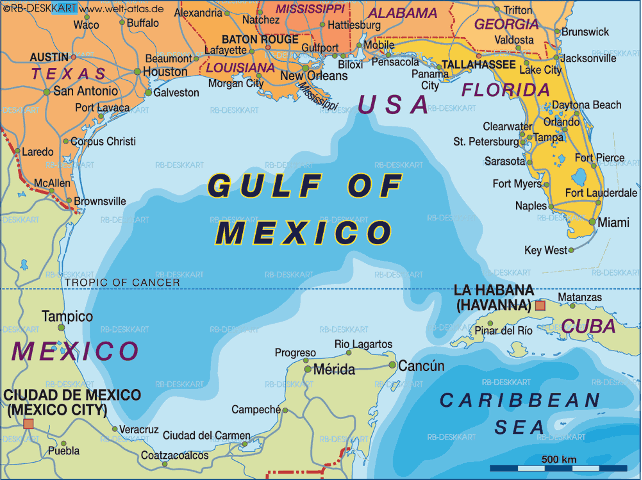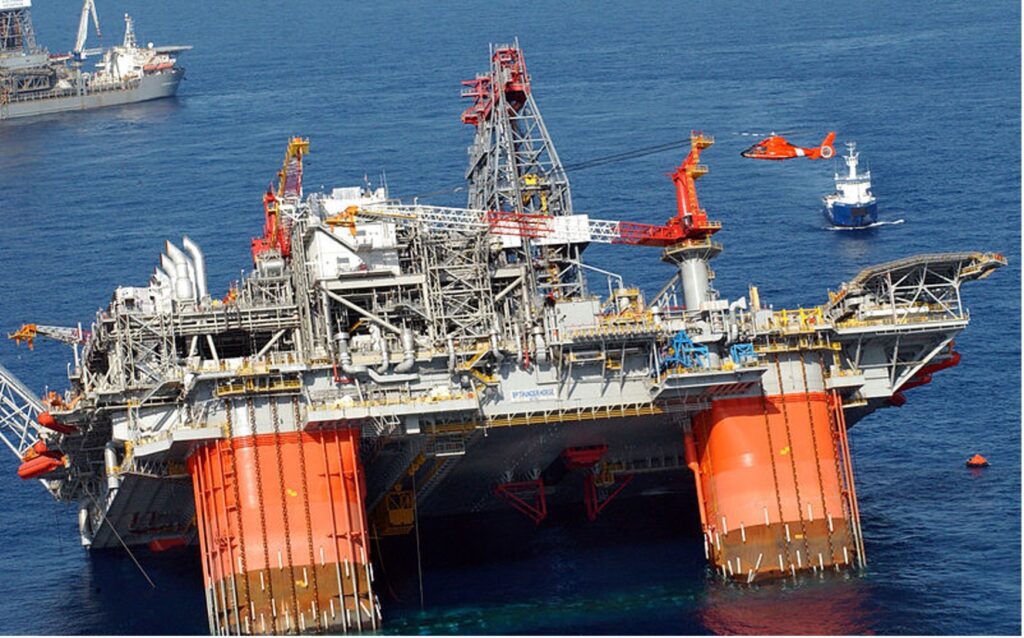The Gulf of Mexico is an ocean basin that is next to the United States’ southern coast. It is bordered by the North American continent on the north, the Mexican states on the southwest and south, and Cuba in the southeast.
The Gulf of Mexico is a body of water that is often referred to as the United States’ “Third Coast” (besides its Atlantic and Pacific coasts).
The Straits of Florida are a series of waterways that connect the Gulf of Mexico to the Atlantic Ocean, and the Yucatan Channel connects the Gulf to the Caribbean Sea. The Gulf has a total area of approximately 1,680,000 square kilometers (650,000 square miles) and a maximum depth of approximately 7,020 meters (23,000 ft).
Gulf of Mexico Oil Rig Platforms & Pipelines
It is a popular fishing destination, and its waters are used for transportation, recreation, and tourism. The basin produces 2 million barrels of oil per day, making it the western hemisphere’s second most productive oil basin.
How Many Oil Rigs Are In the Gulf Of Mexico?
This is a hard question to answer. The number of oil rigs in the Gulf of Mexico can vary on a day-to-day basis, as companies frequently lease and unlease rigs as the price of oil changes.
Several oil platforms abound in the Gulf, however, and these provide a vital service to the economy of the United States by being used to extract oil and natural gas from beneath the seafloor. As of April 2020, there were approximately 1789 platforms in the Gulf of Mexico.
A chronology of oil and gas rig installations in the Gulf of Mexico, showing the increased number of rigs and the greater installation depths, ending by displaying the location of BP’s Deepwater Horizon explosion.
The platforms are huge, and they are a hazard to boats and ships. In order to prevent collisions, the United States Coast Guard maintains a system of traffic lanes around the platforms. These lanes are delineated by buoys, and boats and ships must obey them.
The Coast Guard also maintains a system of warning lights on the platforms, which warn boats and ships of the presence of the platforms. They are different colors, depending on the direction in which they face.
History of Oil Platforms in the Gulf of Mexico
Oil platforms in the Gulf of Mexico have a long and colorful history. They first started appearing in the Gulf in 1947, and over the years, they have been used for a variety of purposes.

The first platforms were tiny and were used to extract oil from near-shore wells. As time went on, the size and complexity of the platforms increased. In the 1970s, the first platforms were built in deep water, and since then they have become increasingly large and complex.
Today, there are over 4,000 oil platforms in the Gulf of Mexico. They play an important role in the economy and support thousands of jobs.
How Far Are Oil Rigs Off The Coast?
As technology has progressed over the years, oil companies have extended drilling and production farther and farther from shore, and into deeper and deeper waters. In the Gulf of Mexico, they start at the state waterline (nine nautical miles out) and go all the way beyond the edge of the continental shelf 100 miles offshore to about 350 miles from Gulf Shores.
What Is The Biggest Oil Rig In The Gulf Of Mexico?
The Thunder Horse oil rig is the biggest in the Gulf of Mexico. It weighs approximately 250,000 tons and can produce up to 250,000 barrels of oil each day. The rig is owned by BP and is located approximately 150 miles south of New Orleans. Thunder Horse is a floating production, storage, and offloading (FPSO) vessel with a storage capacity of 1 million barrels of oil.

In July 2005, Thunder Horse was evacuated in the face of Hurricane Dennis. After the hurricane passed, the platform was listing badly. The cause is still unknown
Abandoned Oil Rigs In The Gulf Of Mexico
An abandoned oil rig is a structure that has been used for drilling for oil and gas but is no longer operative. These rigs can be a hazard to the environment if they are not properly secured. In addition, they can be a target for vandalism and looting.
The Gulf of Mexico is home to over 4,000 abandoned oil rigs. The majority of these oil rigs were abandoned between the late 1970s and early 1990s when oil prices plummeted below $10 per barrel and the offshore drilling industry went into decline.
Many of these rigs were simply abandoned, leaving them to rust and fall apart. They are a ticking time bomb, and the longer they remain in the water, the greater the risk of an environmental disaster.
Everyone remembers when the drilling oil rig Deepwater Horizon was caught by the fire and spilled a record amount of oil into the sea. Environmental consistencies are impossible to measure, however, financial claims are not subject to evaluation, and the case is closed in court.
In recent years, there has been a renewed interest in offshore drilling in the Gulf of Mexico. As a result, the number of abandoned oil rigs in the Gulf has also increased.
There is now a general belief that oil companies must be held accountable for their actions. They must be made to clean up the mess that they have made.
Maintenance and Repair of Oil Platforms
Oil platforms are an important part of the oil and gas industry. They are used to extract oil and gas from offshore wells. The maintenance and repair of these platforms are a critical part of the industry. It is important to keep them in good condition so that they can operate safely and efficiently.
There are several things that need to be done to maintain and repair an oil platform. Some of the most common tasks include painting, repairing damage, and servicing equipment. It is also important to keep the platform clean so that it does not become a breeding ground for bacteria and other contaminants.
The maintenance and repair of oil platforms is a complex process. It requires a lot of skill and experience. The workers who perform this task must be able to work in a dangerous environment. They must also be able to respond quickly to emergencies.
Future of oil in The Gulf Of Mexico
The main reason the Gulf of Mexico is such a hotbed for oil and gas exploration today is that it is stuffed full of so-called source rocks. The scorching temperatures within the Earth then cooked the source rocks, turning them from lipid-rich to oil-and-gas-rich.
The Gulf of Mexico crude oil production will increase with new projects in 2021 and 2022. Production is forecast to exceed 2020 levels, reaching 1.71 million b/d in 2021 and 1.75 million b/d in 2022. Since 2000, the highest crude oil production year was 2019 at 1.9 million b/d.
Can You See Oil Rigs On Google Maps?
Oil rigs are one of the most important – and impressive – symbols of the oil and gas industry. They can be seen from miles away, towering over the landscape. But can you actually see them on Google Maps?
The answer is yes, you can see oil rigs on Google Maps. However, the level of detail will depend on your zoom level. If you’re looking at a satellite image of an area, you’ll be able to see the outline of an oil rig. If you’re looking at a map of an area with street view enabled, you’ll be able to see the actual rig.
- Types of Gas Carriers as per IGC Code – April 22, 2025
- Wind-Assisted Propulsion Systems (WAPS): A Game Changer for Maritime Decarbonization – February 6, 2025
- 10 Boat Salvage Yards in California – January 25, 2025






